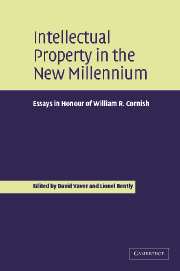Book contents
- Frontmatter
- Contents
- List of contributors
- Foreword
- Preface
- General intellectual property
- Patents and plant protection
- 5 Creating the community patent and its court
- 6 Patents – what's invention got to do with it?
- 7 Common law and civil law approaches to patent claim interpretation: ‘fence posts’ and ‘sign posts’
- 8 Indirect infringement of patents in Israel: judge-made law
- 9 Genomics and the food industry: outlook from an intellectual property perspective
- 10 From ‘outmoded impediment’ to global player: the evolution of plant variety rights
- Trade marks and unfair competition
- Copyright, moral and neighbouring rights
- William R. Cornish – curriculum vitae
- Index
7 - Common law and civil law approaches to patent claim interpretation: ‘fence posts’ and ‘sign posts’
Published online by Cambridge University Press: 25 May 2010
- Frontmatter
- Contents
- List of contributors
- Foreword
- Preface
- General intellectual property
- Patents and plant protection
- 5 Creating the community patent and its court
- 6 Patents – what's invention got to do with it?
- 7 Common law and civil law approaches to patent claim interpretation: ‘fence posts’ and ‘sign posts’
- 8 Indirect infringement of patents in Israel: judge-made law
- 9 Genomics and the food industry: outlook from an intellectual property perspective
- 10 From ‘outmoded impediment’ to global player: the evolution of plant variety rights
- Trade marks and unfair competition
- Copyright, moral and neighbouring rights
- William R. Cornish – curriculum vitae
- Index
Summary
A legal system providing a property right in a human creative effort rests on two fundamental bases: the standards for establishing the right and the scope of the right. Copyright law requires that an author's work be original, and it confers on the author exclusive rights against unauthorized copying, distribution and other activity of works that are substantially similar in expression to the protected work. Similar requirements are imposed by trademark law for product and service identification symbols and by patent law for inventions.
To define the scope of an intellectual property right, legal systems have adopted one of two approaches. First, protection scope can be defined by a direct comparison of the creator's work and an accused work. Copyright and trademark law follow this approach for determining protective scope, that is, infringement. Consider a copyright example. An author's work, a play ‘Romeo and Juliet’, portrays the travails of young lovers from contrasting family cultures in Verona, Italy, centuries ago. An unauthorized accused work, a motion picture ‘West Side Story’, portrays a similar story set in twentieth-century New York. The author's copyright is infringed if the accused work is judged to be substantially similar in expression to the protected work. For trademark law, the inquiry is analogous. One company adopts a trademark ‘Lexis’ for legal data bases. Later, another company uses ‘Lexus’ for luxury automobiles.
- Type
- Chapter
- Information
- Intellectual Property in the New MillenniumEssays in Honour of William R. Cornish, pp. 96 - 108Publisher: Cambridge University PressPrint publication year: 2004

